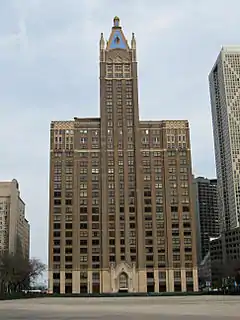Woman's World's Fair
The first Woman's World's Fair was held in Chicago in 1925. The idea of the completely women-run fair was to display the progress of ideas, work, and products of twentieth-century women.

Description
The first Women's World's Fair was held April 18–25 of 1925 in Chicago at the American Furniture Mart Building and officially opened by First Lady Grace Coolidge.[2][3] The eight-day fair was the idea of Helen Bennett[4] and Ruth Hanna McCormick. It was run entirely by women and consisted of 280 booths representing some seventy women occupations. The fair drew about 200,000 visitors, earning a net of some $50,000.[5]
The fair's purpose was to display women's ideas, work, and products for the twentieth century. At the 1876 Centennial Exposition there had been a Women's Pavilion funded and organized by women and in particular Elizabeth Duane Gillespie. The building was over 200 square feet (19 m2) and it was in the shape of a Maltese cross.[6] The Chicago World's Fair of 1893 demonstrated some women's handicrafts in a sewing exhibit, but this fair was to show the progress women had made in seventy industries since then.[2] A side benefit of the fair was that it raised money for the women's Republican Party organizations. The exhibits showed women's accomplishments in the arts, literature, science, and industry. These exhibits were also an inspiration to young women in their new careers. One of the exhibitors was Illinois Bell Telephone Company. Others were newspapers, manufacturers, hospitals, banks, and retail stores. Many local enterprises had employment opportunities.[7]
Women lawyers, inventors, and artists had booths demonstrating women's contributions in these fields. As an example, American sculptor Harriet Whitney Frishmuth was represented by her 1920 bronze work Joy of the Waters.[8] Women's organizations were represented by the Women's Trade Union League, Business and Professional Women's Club, the Visiting Nurse Association, the YWCA, Hull House, the Illinois Club for Catholic Women, and the Auxiliary House of the Good Shepherd.[7]
Speeches
A group of about one thousand women from Sycamore, Illinois, on April 23 had breakfast with famous women. An all woman's orchestra furnished music. The speakers were women of notoriety which included women authors, business women, and various women artisans. The speeches were limited to five minutes. The main speaker was Nellie Tayloe Ross, the only state governor there. Another speaker was the collector of internal revenue of Chicago. Another was the secretary of the Cabinet Department of Commerce for President Herbert Hoover. The medical profession was represented by Dr. Alice Hamilton of Harvard University. The legal profession was represented by Judge Kathryn Sellers of Washington, D.C.[9]
Program
Whiting Hall was visited by the women after the speeches. The booths where artistically decorated showing some of a hundred or so different occupations in which women were employed. Some of these were antique needlework, pottery, silver fox farming, and goat breeding. Examples that received special attention were nurses and welfare workers. A key note was emphasis on earnestness, punctuality and thoroughness in whatever line of work was undertaken.[9]
A unique feature of the first Woman's World's Fair was a daily program. There was a particular topic for each day. Besides being instructive it was entertaining. Music and dancing were especially emphasized each day. Bennett was the general director of the fair. The woman's fair was a success and held for three additional years.[7][9]
References
- Roth, Marian (2015). "Guide to articles in Chicago History magazine". Chicago History. Retrieved September 4, 2015.
Topic: April 18, 1925 was a raw, cold day, but a large crowd had gathered outside Chicago's Furniture Mart on North Lake Shore Drive for the opening of the Woman's World's Fair, an exposition to publicize the entry of women into nearly every field of endeavor.
- Kane 1997, p. 125.
- "1925". Journal of American Insurance. 40: 8.
First Woman's World Fair opened April 18 in Chicago by Mrs. Calvin Coolidge, First Lady of the U.S.
- Ganz 2012, p. 101.
- Sawyers, June (May 15, 1988). "A Fair First In The Women's Movement". Chicage Tribune. Chicago, Il. Retrieved September 4, 2015.
On April 25, 1925, the first Woman's World Fair closed a successful eight-day run at the Furniture Mart on North Lake Shore Drive. The fair, which highlighted women`s achievements in art, commerce and industry, attracted more than 200,000 visitors, presented more than 100 exhibitions of women in business and earned a net income of $50,000.
- Women's pavilion, The Centennial Exposition, Page 116, Retrieved 11 September 2015
- Maureen A. Flanagan (2005). "Woman's World's Fair, 1925". Encyclopedia of Chicago. Chicago, Illinois: Chicago Historical Society.
- Gerdts 1989, p. 128.
- "Woman's World's Fair in Chicago". The True Republican. Sycamore, Illinois. April 29, 1925.
Sources
- Ganz, Cheryl R. (January 2012). The 1933 Chicago World's Fair: A Century of Progress. University of Illinois Press. ISBN 978-0-252-07852-1.
- Gerdts, Abigail Booth (1989). An American Collection: Paintings and Sculpture from the National Academy of Design. The Academy.
- Kane, Joseph Nathan (1997). Famous First Facts, Fifth Edition. The H. W. Wilson Company. ISBN 0-8242-0930-3.
The first Woman's World Fair was held in Chicago, IL, April 18–25, 1925, to demonstrate women's progress in 70 industries. At the Chicago World's Fair of 1893, women's handicrafts had been featured only at the sewing exhibit. The Woman's World Fair was officially opened by Grace Coolidge, the wife of President Calvin Coolidge.